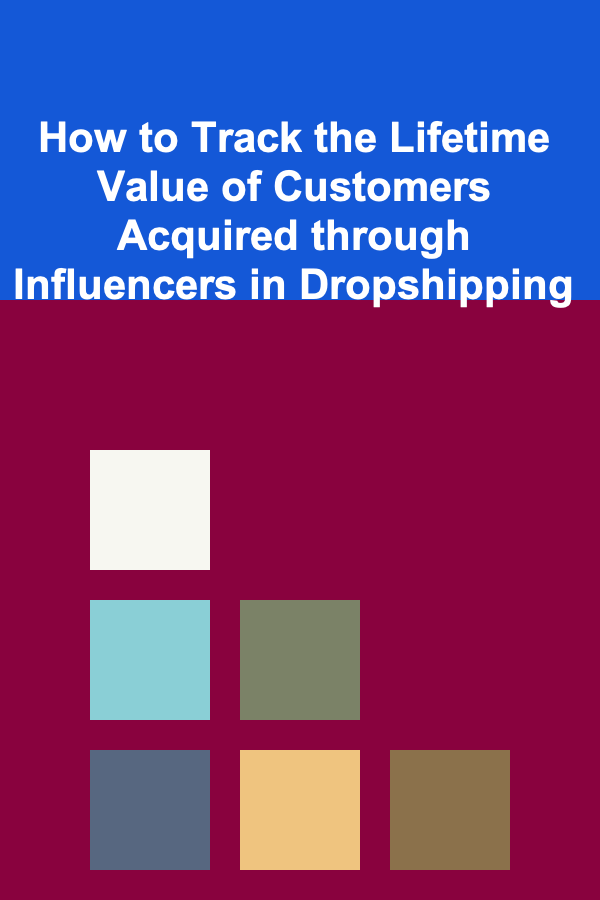
How to Track the Lifetime Value of Customers Acquired through Influencers in Dropshipping
ebook include PDF & Audio bundle (Micro Guide)
$12.99$9.99
Limited Time Offer! Order within the next:

Influencer marketing has emerged as a powerful strategy in the dropshipping world, offering a unique way to acquire customers through the influence of social media personalities and content creators. But as with any marketing strategy, it's essential to measure and track the long-term value of the customers acquired. This is where Customer Lifetime Value (CLV) becomes crucial.
Customer Lifetime Value is a key metric that estimates the total revenue a business can expect from a single customer during their relationship with the company. When it comes to influencer-driven customer acquisition, tracking CLV can be more complex due to the indirect and often multi-touch nature of these marketing campaigns. However, doing so is important for assessing the true effectiveness of influencer marketing in the context of a dropshipping business.
In this actionable guide, we will walk you through the steps of tracking CLV for customers acquired through influencers in a dropshipping setup. We will cover why this is important, how to calculate it, and the best strategies to optimize your influencer marketing campaigns for long-term profitability.
Why Tracking CLV for Influencer-Acquired Customers Is Important
Before diving into the specifics of how to track CLV, it's important to understand why it matters, especially when working with influencers:
- Measure ROI: Tracking the lifetime value of customers acquired through influencers helps assess the return on investment (ROI) of your influencer campaigns. If you are spending money on influencer collaborations, you need to know if the customers you acquire will provide long-term value.
- Optimizing Marketing Spend: Knowing which influencers bring in high CLV customers allows you to allocate marketing budgets more effectively, focusing on influencers who bring in the best quality customers, not just volume.
- Customer Retention Insights: Tracking CLV gives you insights into how well your brand retains customers. A high CLV indicates strong customer loyalty, which can be an important factor in refining your marketing strategy.
- Influencer Performance: Different influencers can have varying impacts on customer behavior. By tracking CLV, you can identify which influencers are driving customers who generate higher value over time, helping you build stronger, more targeted partnerships.
Understanding Customer Lifetime Value (CLV)
Before tracking CLV, it's important to understand what it is and how it can be calculated. CLV is a prediction of the total revenue you can expect from a customer during their entire relationship with your business.
Basic CLV Formula:
CLV=Average Order Value×Purchase Frequency×Customer LifespanWhere:
- Average Order Value (AOV): The average amount spent by a customer per order.
- Purchase Frequency: The average number of purchases a customer makes in a given period (usually annually).
- Customer Lifespan: The average length of time a customer continues to buy from your business.
For influencer-acquired customers, the challenge is that these customers may have different behavior patterns compared to those acquired through other channels, so a deeper analysis is necessary.
Setting Up Tracking for Influencer Marketing Campaigns
The first step in tracking CLV for influencer-driven customers is setting up a system to track the source of acquisition. Without clear tracking, it becomes impossible to attribute customer purchases back to a specific influencer.
3.1. Use Unique Tracking Links
One of the most common methods of tracking customers from influencer campaigns is by using unique tracking links. These are customized URLs that influencers share with their audience. These links direct customers to your store and allow you to track:
- Clicks: How many people clicked on the link.
- Conversions: How many of those clicks led to a purchase.
- Referrals: Which influencer or campaign is driving the most traffic and sales.
Tools like Bitly , Google Analytics UTM parameters , and Affiliatly (a popular affiliate marketing tool) can help you generate and track these links. With proper tracking links in place, you can ensure that you attribute every customer acquired through an influencer to the correct source.
3.2. Implement Referral Codes
Along with unique tracking links, you can provide influencers with discount codes or referral codes to share with their followers. This allows you to track which customers came from which influencer based on the code used during checkout. This is particularly useful for identifying repeat customers who continue to buy from your store after the initial influencer-driven acquisition.
3.3. Set Up Customer Segmentation
Once you start capturing data on customers who come through influencer campaigns, segment these customers in your CRM or eCommerce platform. Many platforms like Shopify, WooCommerce, or Klaviyo allow you to tag customers based on the traffic source or the influencer code they used.
By segmenting customers from each influencer, you'll be able to track their behavior separately from other customers. This segmentation is key to calculating and comparing CLV across different influencer-driven customer groups.
Calculating CLV for Influencer-Acquired Customers
With proper tracking in place, it's time to calculate the CLV for customers acquired through each influencer. The process involves looking at data over a set period and calculating the average value for the factors in the basic CLV formula. Here's a breakdown:
4.1. Track Average Order Value (AOV)
Calculate the average order value for customers acquired through each influencer. This is simply the total revenue generated from these customers divided by the number of orders they've placed.
4.2. Determine Purchase Frequency
Calculate how often customers acquired through each influencer make a purchase. You can do this by dividing the total number of orders by the total number of unique customers within the tracked period.
4.3. Calculate Customer Lifespan
Customer lifespan can be trickier to calculate, as it involves tracking the length of time a customer continues to buy from your store. For dropshipping businesses, customer retention rates tend to be lower compared to subscription-based models, so you may need to track this metric over a period of 12 to 24 months to get a clear picture of customer longevity.
4.4. Factor in Customer Retention
Since influencer-driven customers may have different buying behaviors, consider the retention rates for each influencer. You can calculate retention as the percentage of customers who make repeat purchases within a certain period after their first purchase. If a particular influencer is bringing in customers who are more likely to make repeat purchases, their CLV will be higher.
Analyzing and Optimizing CLV for Influencer Marketing
Once you have calculated the CLV for customers acquired through different influencers, you can begin analyzing the results and making data-driven decisions for your business.
5.1. Compare CLV Across Influencers
Compare the CLV of customers acquired through different influencers to see who is driving the most valuable customers in the long term. Influencers who generate customers with a higher CLV should be prioritized for future campaigns.
5.2. Identify High-Performing Influencers
Look for patterns in your analysis. Are there specific types of influencers (e.g., micro-influencers vs. macro-influencers) that tend to bring in customers with higher lifetime value? This can help you optimize your future partnerships and marketing efforts.
5.3. Adjust Your Marketing Strategy
Once you identify which influencers are bringing in high-CLV customers, consider increasing your investment in those partnerships. You can offer higher commissions, create exclusive campaigns, or even work on long-term collaborations to further increase CLV.
5.4. Focus on Retention Strategies
If you notice that customers acquired through influencers have low retention rates, consider implementing retention strategies such as email marketing campaigns, loyalty programs, or personalized offers to boost repeat purchases and extend customer lifespan.
Leveraging CLV Insights for Long-Term Business Growth
Tracking the lifetime value of customers acquired through influencers is not just about measuring past performance--- it's about using this data to inform future decisions. By focusing on influencer partnerships that drive high-CLV customers, optimizing retention strategies, and refining your marketing spend, you can significantly improve the profitability of your dropshipping business.
The key to success lies in understanding the long-term impact of influencer marketing. By tracking CLV, you gain valuable insights into customer behavior, allowing you to make informed decisions that will drive long-term growth and success for your dropshipping business.
Reading More From Our Other Websites
- [Home Party Planning 101] How to Throw an Allergy-Friendly Home Party: A Comprehensive Guide
- [Home Maintenance 101] How to Fix a Broken Window Screen and Prevent Future Damage: An Expert's Advice
- [Rock Climbing Tip 101] The Art of Traditional Climbing: Mastering Gear Placement and Route Reading
- [Organization Tip 101] How to Organize Your Memory Box for Keepsakes
- [Home Cleaning 101] How to Clean Your Home's Baseboards and Moldings
- [Sewing Tip 101] Top 10 Must-Have Sewing Needles for Hobbyists and Professionals
- [Personal Investment 101] How to Choose an Online Broker to Maximize Your Investment Strategy
- [Personal Care Tips 101] How to Choose a Mascara That Will Not Irritate Your Eyes
- [Organization Tip 101] DIY Quartz Countertop Repair: Tips for Successful Restoration
- [Digital Decluttering Tip 101] The Science of Screen Time: Balancing Efficiency and Burnout

Cost Accountant's Toolkit: Essential Skills and Techniques for Financial Control
Read More
How to Curate a Favorite Moments Album
Read More
How to Find Financial Resources for Entrepreneurs
Read More
How to Simplify Family Meal Prep for Busy Nights
Read More
How To Become a Children's Party Entertainer
Read More
How to Make Natural Cleaning Products at Home
Read MoreOther Products

Cost Accountant's Toolkit: Essential Skills and Techniques for Financial Control
Read More
How to Curate a Favorite Moments Album
Read More
How to Find Financial Resources for Entrepreneurs
Read More
How to Simplify Family Meal Prep for Busy Nights
Read More
How To Become a Children's Party Entertainer
Read More